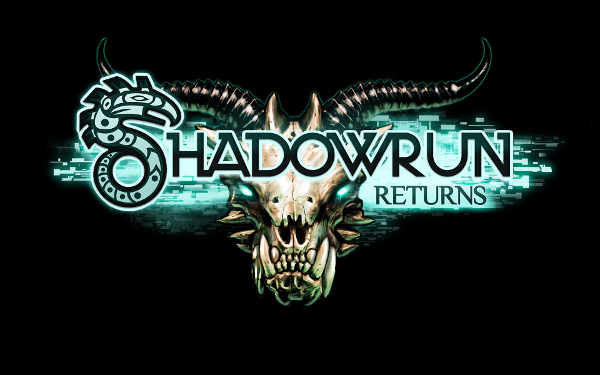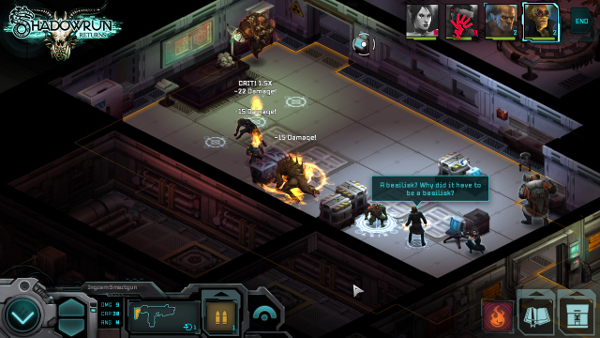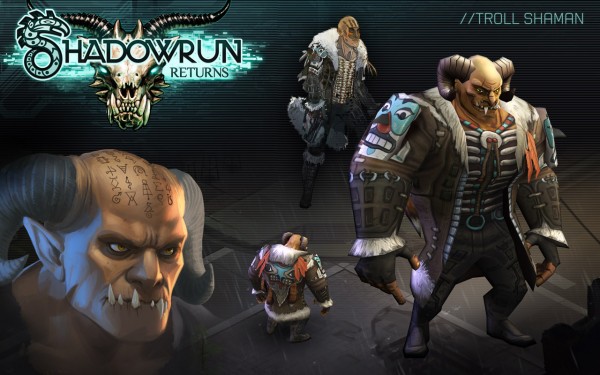
With credits that include Battletech (Mechwarrior), Crimson Skies, Mage Knight and Pirates of the Spanish Main, I think it’s safe to say Jordan Weisman has done more for nerd culture than Hurley Smith and Chaleo Yoovidhya combined, and so it was quite the honor when I got the chance to talk to him about his new project Shadowrun Returns, the latest video game based on his long-running pen & paper RPG.
Maxwell Patterson: It seems that if your Kickstarter success is proof of anything, it’s that Shadowrun still has a lot of diehard fans in 2013. Yet for your average PC gamer or tablet user, what does the Shadowrun name mean these days?
Jordan Weisman: Well it’s an excellent question, and something we are anxious to find out. [Shadowrun] being 25 years old, it’s percolated a lot of concepts into popular culture. One of the things we realized working on the trailer for the game was that we didn’t have to spend a lot of time legitimizing the mix of high fantasy and cyber punk because in the last 25 years it’s become an accepted trope. Even though Shadowrun introduced it, it’s now moved out into so many different games and videos and things like that. It’s been there. In some respect we’ve seen the dissemination it will be interesting to see how many current gamers who weren’t familiar with the original property will recognize where some of these things came from and tie it back to the original property.
But I think beyond fictionally, the gameplay we’re trying to offer is an interesting hybrid between a throwback and a very modern game. It’s got a little bit more of the detailed team management that you would expect to see from a game from the 90s for instance. But it’s a got a much slicker UI and the ability to make that process much more accessible and fluid than the games in the 90s. It’s that kind of mix of the details of an old retro game and the accessibility of a modern game.
Max: You guys haven’t made any bones about the fact that is not going to be the kind of game that holds your hand, even though as you said it is more streamlined. Do you see Shadowrun Returns as something that’s going to bring Shadowrun into the popular gaming circles, or is this more of a love letter to the classic, old-school fans?
Weisman: You’ve hit on the issue we’ve been wrestling with the entire development because luckily the property has this very loyal fanbase. They’re the ones who’ve helped bring this project to reality with their funding and Kickstarter and their continued support, so it is a love letter to them. Yet as we’ve acknowledged from the very beginning it’s in their interest as well as ours to make sure that this is a reintroduction of the universe to the larger game audience, to people who have never heard of Shadowrun, because otherwise the 40,000 people who supported us on Kickstarter aren’t enough to make a viable game. We need to reach hundreds of thousands of people. So we’ve been very conscious of the fact that we’re trying to make a game for a much broader audience than the people who reached out right away on Kickstarter. It’s not a casual game, it’s a gamer’s game, it is deep tactics on the combat and management of the resources and team, so it is a gamer’s game. We think there is a big audience for people who love that kind of game and are looking for something new in the genre.
Max: This is the 3rd Game from Harebrained Schemes, with the first two (Crimson and Strikefleet Omega) being exclusive to the tablet and iOS format. Is Shadowrun Returns a natural evolution of what the studio has worked on in the past given its cross-platform release?
Weisman: It is, and the studio has grown a great deal over the last year. We went from ten to 30 people to build this project; it’s a much larger project than the other two. What I love about this studio is it’s a real mix of ancient dinosaurs like myself who have built hundreds and hundreds of games over the last 30 years and a bunch of really, really talented young people who are bringing all sorts of new energy and creativity to it. It’s a very exciting studio for me and having worked at everything from giant corporations like Microsoft to garage shops it’s great when the pieces come together in a fun way, and luckily that’s what Harebrained Schemes has been.

Max: At the risk of sounding cynical, this is the first of Harebrained’s games that is getting a Steam release. How would you answer people who say this may just be a glorified tablet game, or does that distinction even matter anymore?
Weisman: Well if you look at the power of the tablets it exceeds the power of any of the PCs that the games were originally released on in the 90s. I think it’s a UI distinction and a case of play where and how you want to play, it’s not about power or what the platform is capable of. Yes, the majority of things on those platforms are not gamer games because the platforms are so widely distributed and in so many demographics’ hands. The fact that all those demographics are playing games of some sort is a fantastic thing for gamers, because people’s tastes and interests will evolve and it’s keeping the entire industry interesting from a long term perspective. Just because they’re using the platform for non-gamer games doesn’t mean it’s not capable of a deep game.
The reason we think it’s interesting to have brought a version of this game to the tablets is that the graphics are great, the touch interface in many ways is an optimization of the mouse interface, and it gives you the opportunity to play it lying down on the couch, or on a bus or an airplane, rather than having to always be in your den. But the game is designed to have the depth of gameplay and story that you’d expect out of a PC title.
Max: Another game recently the revived an old franchise was X-Com: Enemy Unknown. Is it heartening seeing an older franchise revived successfully, and does that give you an extra hope for Shadowrun?
Weisman: Absolutely. If you go back to the Kickstarter video a little over a year ago, we called out X-Com as the inspiration point for where we wanted to take our tactical combat system in the game, with the kind of quasi-three quarter isometric perspective. The original game was definitely a touchstone for us as we started on the development of [Shadowrun Returns] We had started to already do a lot of our UI updating and work on how to make that kind of gameplay more accessible, and when the new X-Com came out it was like “whoa, look, these guys have gone down a lot of the same roads we’re going down…” What they did is sort of leap-frogged us, because they got rid of things like action points all together whereas we had not. We kept action points in terms of an economy and resource for how you manage what you are doing, we had come up with a more accessible version of actions points than the original X-Com. We’re kind of in a middle ground between the old X-Com and the new in terms of where our gameplay sits, it retains some of the resource management of the old X-Com, but a lot of the accessibility, UI and flow of the new X-Com.
Max: Now X-Com came out as a $60 retail release, while Shadowrun Returns is coming out at a lower $20 price point. Was that approach motivated solely by the Kickstarter angle or was that your intent all along?
Weisman: Well their budget was likely 20 times our budget and hundreds and hundreds of man years went in to that project. We’re a small studio, and we’ve worked a little over a year, but our take was different. We never intended to be something that would be competitive at as a $60 retail product; we view ourselves as a small indie studio who kind of views it as a community development project in the sense that A.) It was funded by the community and B.) The real lifeblood of this is going to be the community generated content. There isn’t an X-Com editor, you can’t go out and create your own X-Com levels and stories. A lot of our premise was that Shadowrun has always been a shared world, a world where the players can tell their own stories on the pen and paper side. Back in the 90s it’s something I would have loved to do but couldn’t on the consoles, UGC [User Generated Content] just wasn’t a deal then. But now it is, and we want to robustly embrace that. Not only are we releasing the level editor for people to make all their own content, but we’re taking our entire first campaign and releasing it all in level editor files so that people can just go at it, hack at it, change it however they want. We don’t view that initial story as the story of Shadowrun, we view it as the first story of Shadowrun and the whole point is to have it become hopefully the first of many, many stories generated by us and the audience.
Max: If Shadowrun Returns is a success, would you be interested in pursuing a larger Shadowrun project down the line?
Weisman: For us the hope is that the sales of the title will allow us to continue to develop the tool set for the world, so we can continue to add more tools to our and the audience’s ability to tell stories. Our aspiration isn’t really to go out and make a $40 million dollar version of Shadowrun, our aspiration is to continue the funding of this kind of collaborative storytelling tool set and for us to be able to continue to create new places, characters and art for our own stories, and to use all of that to continue to empower the audience to tell their stories. There are so many things we could add to the Shadowrun world that the pen and paper universe has that time and budget just didn’t allow us to add. We’d love to go into more depth with richer economies, richer versions of the character types, different locations around the world, more characters; there’s so many more things we could stretch into that hopefully the sales of this first title will allow us to do. We view at as hopefully a little bit, not quite apples to apples, but a little bit more like a Minecraft. The goal is to have one title that gets richer and richer in its value to the consumer by the tools it continues to offer.
Max: So we shouldn’t expect to see Shadowrun Returns Again a year from now?
Weisman: Well our current thinking is that what you would hopefully see from us is additional content packs, new building blocks. For instance we’re currently working on Berlin, which is one of the things the Kickstarter audience funded. So that’s going to be a whole bunch of new characters and environments and a new story that we’ll offer. We’d love to keep doing that, and keep adding new game system elements to it. At least our current thought is that’s more in the form of DLC packs, rather than in the form of Shadowrun Returns Returns or Son of Shadowrun Returns.

Max: Looking at the history of Shadowrun video games, you have the Genesis and SNES titles, and then in 2007 you have the team-based FPS. We don’t have to get into the merits of that particular title, but do you see Shadowrun as a franchise that can branch out into different genres, or do you think going back to the roots the way you have is the key to success?
Weisman: I think the universe is certainly rich enough to support different play styles. Our approach to Shadowrun was to hit the core of the RPG experience and the ability for people to tell their own stories within it. Could the universe support an action oriented title? Yes. It would have to be an action-oriented title that was more contextual and more rooted in the mythos. The digs on the 2007 product was that it was called Shadowrun but it wasn’t really well integrated into the mythos of Shadowrun. It had a ton of really innovative game mechanics, a lot of which you see reflected in the new Halo because a lot of the team is the same, so there were a lot of great mechanics there but it just didn’t have the storytelling nature and the mythos built in. But I don’t think that means you couldn’t do that in the Shadowrun universe. I don’t know if that’s our studio, that’s not what we’re set up to do, but it doesn’t mean I think it couldn’t be done well.
Max: Do you think something like Fallout 3 ultimately had a warmer reception because they didn’t make a total shift, but rather melded the two genres?
Weisman: Absolutely. That title had a lot of respect for the setting in which it was put. It brought it to life in a robust way but it didn’t go and throw out [the original] and start over. I think that’s why the audience was concerned initially but then embraced it because they realized, hey wait a minute, it’s like saying you can’t have a novel and a movie set in a same universe. They’re two inherently different experiences, but if they’re well-crafted they can both be enjoyed.
Max: So if someone had handed you a blank check and said “make any Shadowrun game you wanted,” is this the genre you would have picked or would you have experiment with something different?
Weisman: This would have been the genre I picked, absolutely. At the end of the day this is what Shadowrun meant the most to me as the progenitor of it: it’s about the depth of story, it’s about the interactions between wildly divergent characters with different skill sets, it’s about the multiple worlds of Shadowrun stacked up on top of each other, the physical, the matrix and the magical, how you have to work across those simultaneously. That’s what Shadowrun is about and I think this genre of game lets us explore that much easier than other genres. Yes, this would have been my first choice.
Check back tomorrow for Part 2 of the interview, as talk more Kickstarter and reader questions!
Follow me on Twitter
